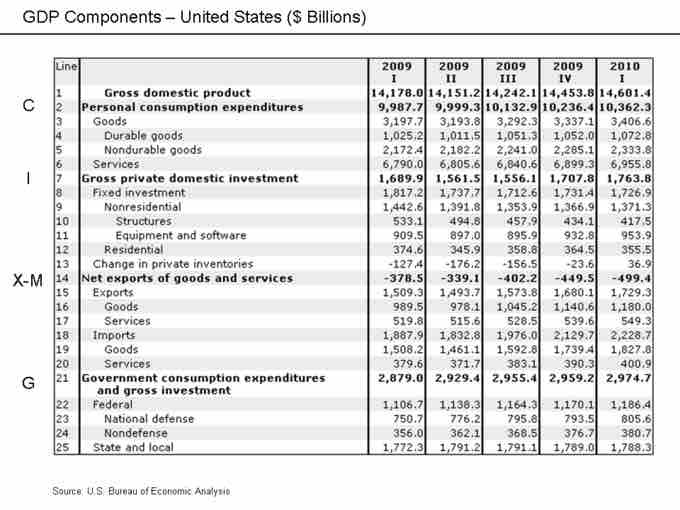What is Gross Domestic Product (GDP)?
GDP is the value of all the final goods and services produced in a country during a given time period. Intermediate goods are not counted because they would cause double-counting to occur. GDP only refers to goods produced within a particular country. For instance, if a firm is located in one country but manufactures goods in another, those goods are counted as part of the manufacturing country's GDP, not the firm's home country. BMW is a German company, but cars manufactured in the U.S. are counted as part of the U.S. GDP. GDP is a measure used by economists to determine how productive a country is on the whole.
GDP per capita is often considered an indicator of a country's standard of living. Under economic theory, GDP per capita exactly equals the gross domestic income (GDI) per capita.

GDP Categories - United States
Components of U.S. GDP
How Is GDP Determined?
GDP can be determined in three ways:
- the product (or output) approach;
- the income approach; and
- the expenditure approach.
The product approach is the most direct, summing the outputs of every class of enterprise to arrive at the total. The expenditure approach works on the principle that all products must be bought by a consumer; therefore, the value of the total product must be equal to consumers' total expenditures. The income approach works on the principle that the incomes of the productive factors must be equal to the value of their products. This approach determines GDP by finding the sum of all producers' incomes.
Example: the Expenditure Approach
The expenditure approach only measures products that are intended to be sold. If you knit yourself a sweater, it is production but does not get counted as GDP because it is never sold. Components of GDP by expenditure are:
consumption + gross investment + government spending + (exports − imports)
Note: In the expenditure-method equation given above, the exports-minus-imports term is necessary in order to null out expenditures on things not produced in the country (imports) and add in things produced but not sold in the country (exports).
Consumption is normally the largest GDP component in the economy. Consumables fall under one of the following categories: durable goods, non-durable goods and services. Examples include food, rent, jewelry, gasoline and medical expenses.
Examples of investment include the construction of a new mine, purchase of software, or purchase of equipment for a factory. Spending by households on items like new houses is also included in investment. Buying financial products is classed as saving, as opposed to investment.
Government spending is the sum of government expenditures on final goods and services. It includes salaries of public servants, purchase of weapons for the military, and any investment expenditure by a government. It does not include any transfer payments like social security or unemployment benefits.
Example: the Production Approach
The production approach is also known as the Net Product or Value Added method. This method consists of three stages:
- Estimating the gross value of domestic output in various economic activities;
- Determining the intermediate consumption -- i.e., the cost of material, supplies and services used to produce final goods or services; and
- Deducting intermediate consumption from Gross Value to obtain the Net Value of Domestic Output.
For measuring gross output of domestic product, economic activities (i.e. industries) are classified into various sectors. After classifying economic activities, the gross output of each sector is calculated by either of the following two methods:
- By multiplying the output of each sector by their respective market price and adding them together, or
- By collecting data on gross sales and inventories from the records of companies and adding them together.
Example: the Income Approach
Another way of measuring GDP is to measure total income. If GDP is calculated this way, it is sometimes called Gross Domestic Income (GDI). GDI should provide the same amount as the expenditure method. However, in practice, measurement errors will make the two figures slightly off when reported by national statistical agencies.
This method measures GDP by adding the incomes that firms pay households for factors of production -- i.e., wages for labor, interest for capital, rent for land and profits for entrepreneurship. The U.S. "National Income and Expenditure Accounts" divide incomes into five categories:
- Wages, salaries and supplementary labor income
- Corporate profits
- Interest and miscellaneous investment income
- Farmers' income
- Income from non-farm unincorporated businesses
These five income components sum to net domestic income at factor cost. Two adjustments must then be made to get GDP:
- Indirect taxes minus subsidies are added to get from factor cost to market prices.
- Depreciation (or capital consumption allowance) is added to get from net domestic product to gross domestic product.

GDP per capita 2011
GDP per capita 2011 for the world economy; with the darkest reds being the highest, and the ligher yellows to white being the lowest.